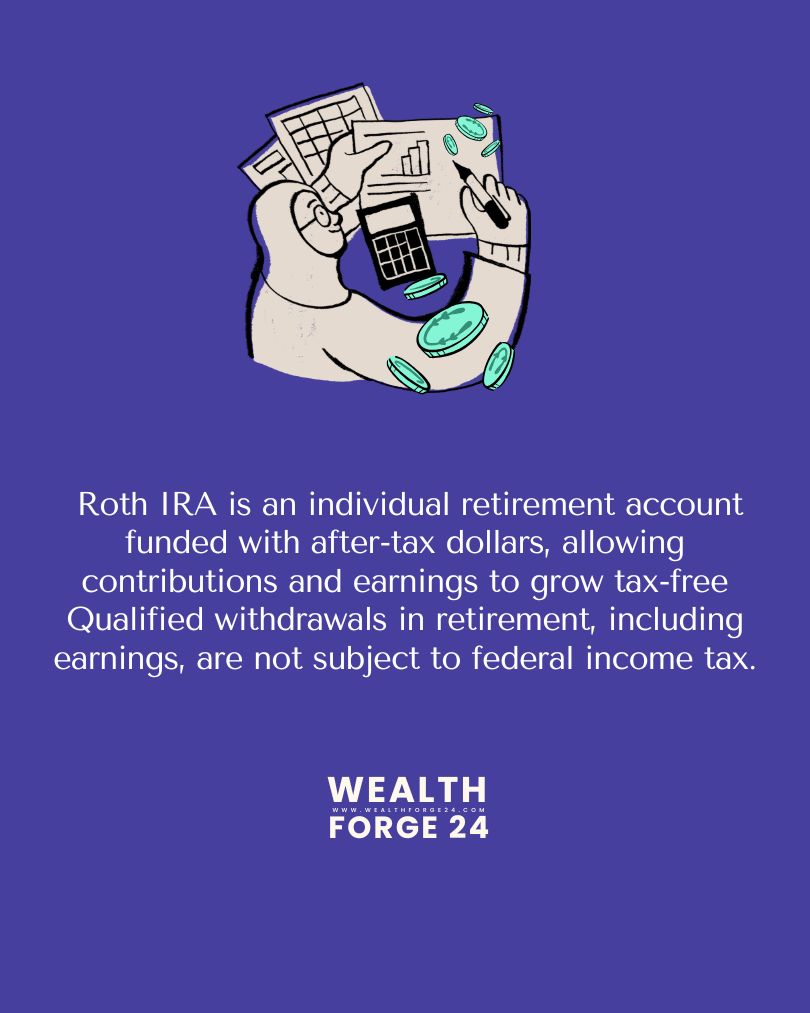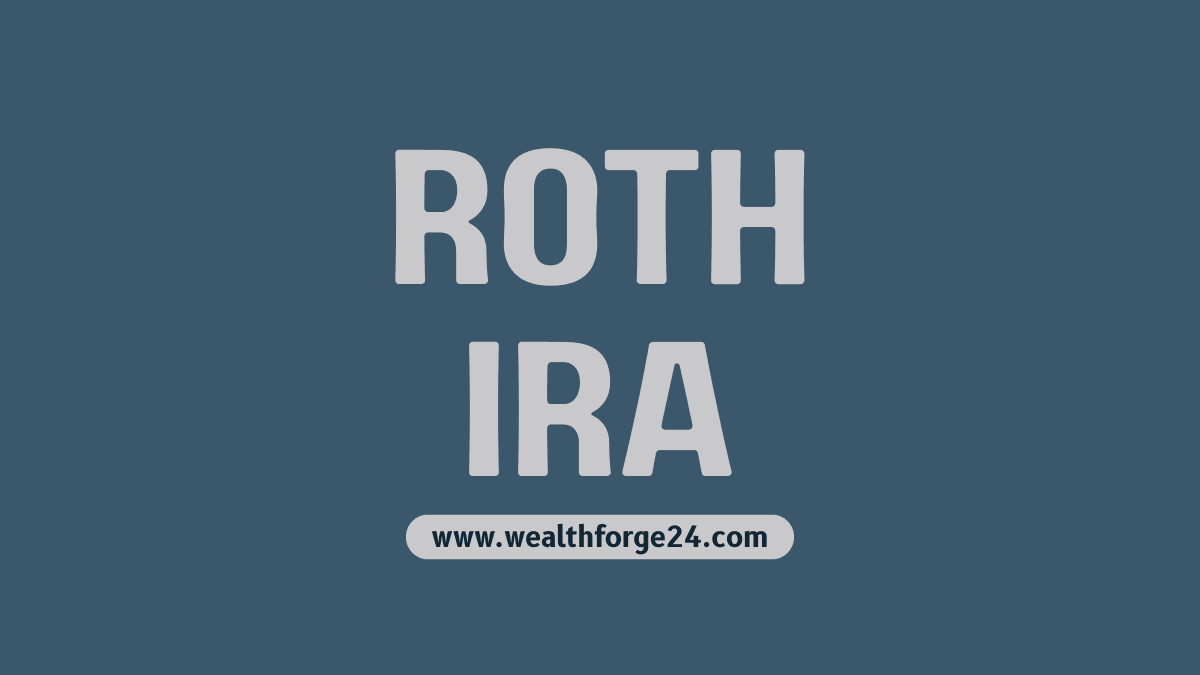What Is a Roth IRA?
A Roth IRA is a type of tax-advantaged person retirement account to which you may make contributions after-tax dollars toward your retirement. Known as an person retirement association by the IRS, the primary advantage of a Roth IRA is that your contributions and the earnings on those contributions can develop tax-loose and be withdrawn tax-free after age 59½, assuming the account has been open for at the least 5 years.
In other words, you pay taxes on cash going into your Roth IRA, after which all future withdrawals are tax-free.
Key Differences from Traditional IRAs
Roth IRAs are much like traditional IRAs, with the biggest difference being how the two are taxed. Roth IRAs are funded with after-tax greenbacks. Unlike a conventional IRA, the contributions aren’t tax-deductible, however after you begin retreating finances, the money you’re taking out is tax-loose.

Key Takeaways
- A Roth IRA is funded with after-tax bucks, allowing each growth and certified withdrawals (after age 59½ and after 5 years) to stay tax-unfastened.
- You can withdraw your contributions at any time—tax-unfastened and without penalty, even supposing you have not met the five-12 months or age necessities.
- Roth IRAs are best if you anticipate your marginal tax charge to be better in retirement than now.
- Single tax filers can’t make a contribution to a Roth IRA in 2025 if their modified adjusted gross income (MAGI) is extra than $165,000, while for married couples submitting mutually, the restrict is $246,000.
- Contribution limits for 2025 are $7,000, or $eight,000 in case you are age 50+.
- Roth IRAs don’t require mandatory distributions (RMDs) all through your lifetime, making them sensible equipment for lengthy-term wealth transfer.
How Does a Roth IRA Work?
You can placed money you’ve got already paid taxes on right into a Roth IRA. When you withdraw earnings when you retire at age 59½ or later and after proudly owning the Roth IRA for five years, you might not must pay any in addition taxes. You can withdraw contributions with out tax or penalty at any time.
Funding Sources
A Roth IRA can be funded from:
- Regular contributions
- Spousal IRA contributions
- Transfers
- Rollover contributions
- Conversions
All Roth IRA contributions have to be made in cash (which includes exams and cash orders) until they’re rollover contributions. They cannot be within the form of securities or assets.
Growth and Flexibility
Similar to different certified retirement plan accounts, the cash invested in a Roth IRA grows tax-unfastened. However, a Roth IRA is much less restrictive than other debts. The account holder can preserve the Roth IRA indefinitely. There are no required minimum distributions (RMDs) throughout their lifetime, as there are with 401(k)s and conventional IRAs.
2025 Contribution Limits
Important: The maximum annual contribution that an individual could make to a Roth IRA in 2025 is $7,000. People age 50 and older can make contributions as much as $8,000.
The IRS limits how much may be deposited annually in any form of IRA, adjusting the amounts periodically. The contribution limits are the equal for traditional and Roth IRAs. These limits observe throughout all of your IRAs, so even when you have more than one accounts you cannot make contributions more than the most.
Allowable Investments in a Roth IRA
Once you’ve got contributed cash to a Roth IRA, you may put money into lots of securities, which include:
- Mutual price range
- Stocks
- Bonds
- Exchange-traded budget (ETFs)
- Certificates of deposit (CDs)
- Money marketplace budget
Prohibited Investments
Prohibited investments consist of life insurance, collectibles, coins (besides sure coins minted by way of the U.S. Treasury), and S-corp inventory.
Self-Directed Roth IRAs
If you want the broadest range of investment options, you need to open a Roth self-directed IRA (SDIRA), a unique category of Roth IRA wherein the investor, now not the economic institution, manages their investments. These free up a universe of possible investments, along with at once making an investment in virtual assets like cryptocurrency.
Opening a Roth IRA
Eligible Institutions
A Roth IRA have to be set up with an institution that has obtained IRS approval to offer IRAs. These consist of:
- Banks
- Brokerage companies
- Federally insured credit unions
- Savings and loan associations
Timing and Documentation
A Roth IRA can be hooked up each time. However, contributions for a tax year must be made with the aid of the IRA proprietor’s tax-filing closing date, that’s normally April 15 of the subsequent year.
Two basic documents should be furnished while an IRA is established:
- IRA disclosure announcement
- IRA adoption settlement and plan report
Choosing a Provider
Not all economic establishments are created identical. Consider these factors:
- Investment alternatives available
- Fee shape and trading fees
- Account minimum necessities
- Additional banking merchandise
- Customer provider exceptional
Compare Top Roth IRA Providers
Leading Providers for 2025
- Account Minimum: $zero
- Fees: $0 for stock/ETF trades, $0 plus $0.65/settlement for options trades
- Account Minimum: $500
- Fees: 0.25% for most accounts; no buying and selling commission
- Account Minimum: $0
- Fees: $zero/inventory and ETF exchange, $zero plus $1 in keeping with contract for alternatives
- Account Minimum: $zero
- Fees: No fee for stock, ETF trades. Options are $0.50-$zero.65 consistent with contract
- Account Minimum: $zero
- Fees: $zero commissions for equities/ETFs on TWS Lite
FDIC Insurance for Roth IRAs
If your account is placed at a financial institution, IRAs fall under a special insurance class from traditional deposit debts. The Federal Deposit Insurance Corp. (FDIC) offers coverage protection as much as $250,000 for conventional or Roth IRA bills, however account balances are mixed rather than considered personally.
What Can You Contribute to a Roth IRA?
The IRS dictates no longer simplest how much cash you could deposit in a Roth IRA but additionally the sort of cash that you could deposit. Basically, you may simplest make a contribution earned profits to a Roth IRA.
Eligible Income Sources
For people running for an agency, eligible repayment includes:
- Wages and salaries
- Commissions and bonuses
- Other quantities paid for services achieved
- Generally, any amount proven in Box 1 of Form W-2
For self-hired people, reimbursement is internet earnings from their commercial enterprise, much less retirement plan contributions and reduced through 50% of self-employment taxes.
Ineligible Income Sources
The following are NOT eligible for Roth IRA contributions:
- Rental income or belongings renovation profits
- Interest earnings
- Pension or annuity earnings
- Stock dividends and capital gains
- Passive income from partnerships
Important: You can in no way contribute greater for your IRA than your earned income in that tax year.
Who’s Eligible for a Roth IRA?
Anyone who has earned income can make contributions to a Roth IRA—so long as they meet sure requirements regarding filing fame and modified adjusted gross profits (MAGI).
2025 Income Eligibility
Married submitting at the same time:
- Full contribution: Less than $236,000
- Partial contribution: $236,000 to less than $246,000
Single, head of family:
- Full contribution: Less than $a hundred and fifty,000
- Partial contribution: $a hundred and fifty,000 to much less than $one hundred sixty five,000
Married filing one after the other (lived with partner):
- Full contribution: $0
- Partial contribution: Less than $10,000
The Spousal Roth IRA
One way that a pair can raise their contributions is with a spousal Roth IRA. An character may also fund a Roth IRA on behalf in their married companion who earns very little earnings.
Requirements
For eligibility, the following requirements have to be met:
- The couple have to be married and document a joint tax return
- The person making the contribution need to have eligible compensation
- Total contributions for both spouses can’t exceed their taxable compensation
- Contributions to 1 Roth IRA can not exceed character limits
Withdrawals: Qualified Distributions
At any time, you may withdraw contributions from your Roth IRA, each tax- and penalty-loose. If you take out handiest an amount identical to what you’ve got installed, the distribution is not taken into consideration taxable income, no matter your age or how long it has been inside the account.
Requirements for Qualified Distributions
For the distribution of account profits to be certified, it must occur as a minimum 5 years after setting up the Roth IRA, AND meet one of these conditions:
- The Roth IRA holder is as a minimum age 59½
- The disbursed property are used closer to shopping a primary domestic (constrained to $10,000 consistent with lifetime)
- The distribution takes place after the holder turns into disabled
- The assets are allotted to the beneficiary after the holder’s loss of life
The Five-Year Rule Explained
If You Meet the Five-Year Rule:
Under age 59½:
- Earnings are subject to taxes and consequences
- Exception: First-time domestic purchase ($10,000 restrict) or permanent incapacity
Ages 59½ and older:
- No taxes or consequences
If You Don’t Meet the Five-Year Rule:
Under age 59½:
- Earnings are difficulty to taxes and penalties
- May keep away from penalty (however not taxes) for first-time home purchase, qualified training expenses, unreimbursed clinical fees, incapacity, or death
Ages 59½ and older:
- Earnings are difficulty to taxes but now not consequences
Non-Qualified Distributions
A withdrawal of profits that don’t meet the necessities may be challenge to income tax or a ten% early distribution penalty. However, exceptions exist if budget are used for:
- Unreimbursed medical charges: Exceeding 7.Five% of AGI
- Medical insurance: If you’ve got lost your activity
- Higher education costs: Tuition, prices, books, components for eligible institutions
- Childbirth or adoption costs: Up to $5,000 within twelve months of the event
Roth IRA vs. Traditional IRA
Whether a Roth IRA is more useful than a traditional IRA depends on numerous elements:
- Your present day tax bracket
- Expected tax charge at retirement
- Personal choice and monetary goals
When Roth IRAs Shine
Individuals who anticipate to be in a higher tax bracket when they retire may locate the Roth IRA greater effective because the full tax prevented in retirement may be greater than the income tax paid in the present. Therefore, younger and decrease-earnings workers may additionally gain the maximum from a Roth IRA.
By beginning to keep early in life, buyers make the most of compound hobby: Your investment and its profits are reinvested and generate extra income, creating a snowball impact.
Inheritance Benefits
Those who do not need their Roth IRA assets in retirement can go away the cash to accrue indefinitely and bypass the assets to heirs tax-free upon death. While beneficiaries need to take distributions from an inherited IRA, they can stretch out tax deferral by means of taking distributions for a decade in most instances.
Traditional IRA beneficiaries, alternatively, do pay taxes on distributions. Also, a spouse can roll over an inherited IRA into a new account and now not need to begin taking distributions until age 73.
What Happens When You Leave a Job?
When you leave a corporation wherein you’ve been employed and you have a 401(okay) plan, keep in mind rolling it right into a Roth IRA. Moving the money into an IRA at a brokerage or bank method avoiding on the spot taxes and preserving the account’s tax-advantaged popularity. What’s greater, you can pick out from a broader variety of investment alternatives than your organisation’s plan offered.
Caution: Funds withdrawn from your 401(okay) ought to be transferred to any other retirement plan within 60 days to avoid taxes and penalties.
Frequently Asked Questions
Is It Better to Invest in a Roth IRA or a 401(k)?
There are many variables to don’t forget. Each type presents tax-unfastened boom opportunities. Roth IRAs don’t provide tax benefits when you deposit, but you can withdraw tax-unfastened in the course of retirement. The reverse is authentic for traditional 401(okay)s.
Additionally, 401(okay)s permit employers to make matching contributions and feature higher contribution limits. However, 401(k)s regularly have better costs, minimal distributions, and less investment options.
How Much Can I Put in My Roth IRA Monthly?
In 2025, the maximum annual contribution is $7,000, or $583.33 month-to-month for the ones below 50. This will increase to $8,000 yearly, or more or less $666.Sixty seven monthly, for people 50 or older.
In evaluation, the 2025 restriction for a 401(k) is $23,500, with an additional $7,500 seize-up contribution for those 50+.
What Are the Advantages of a Roth IRA?
While Roth IRAs don’t consist of an organisation suit, they permit for greater funding variety. For folks that count on being in a better tax bracket while older, tax-loose withdrawals are beneficial. You can also withdraw contributions (now not profits) at any time, tax- and penalty-free.
What Are the Disadvantages of a Roth IRA?
Unlike 401(okay)s, Roth IRAs don’t consist of an prematurely tax smash. Annual contribution limits are approximately a 3rd of 401(k)s. For excessive-earnings individuals, contributions are either reduced or not allowed.
The Bottom Line
A Roth IRA is an character retirement account that lets in you to withdraw money on a tax-unfastened basis after age 59½ and after you’ve got owned the account for 5 years. If you buy a domestic, pay for university, or want price range for childbirth or adoption, you could additionally withdraw without penalty.
For those who assume being in a higher tax bracket while older or retired, Roth IRAs offer a useful choice. The money isn’t taxable in case you’ve met the time requirements, in contrast to withdrawals from a traditional 401(ok) or traditional IRA.
Is a Roth IRA All You Need?
While Roth IRA benefits are powerful—tax-loose withdrawals, penalty exemptions, and capacity for decrease tax fees—it shouldn’t be your simplest retirement account.
“Having specific sorts of debts is high quality as it gives you tax legal responsibility diversification,” said Ed Slott, founder of IRAHelp.Com.
This diversification protects you from placing all destiny income into one tax basket, specially if Congress changes tax policies. Other retirement accounts like 401(okay)s offer benefits Roth IRAs don’t, together with corporation matching contributions.








